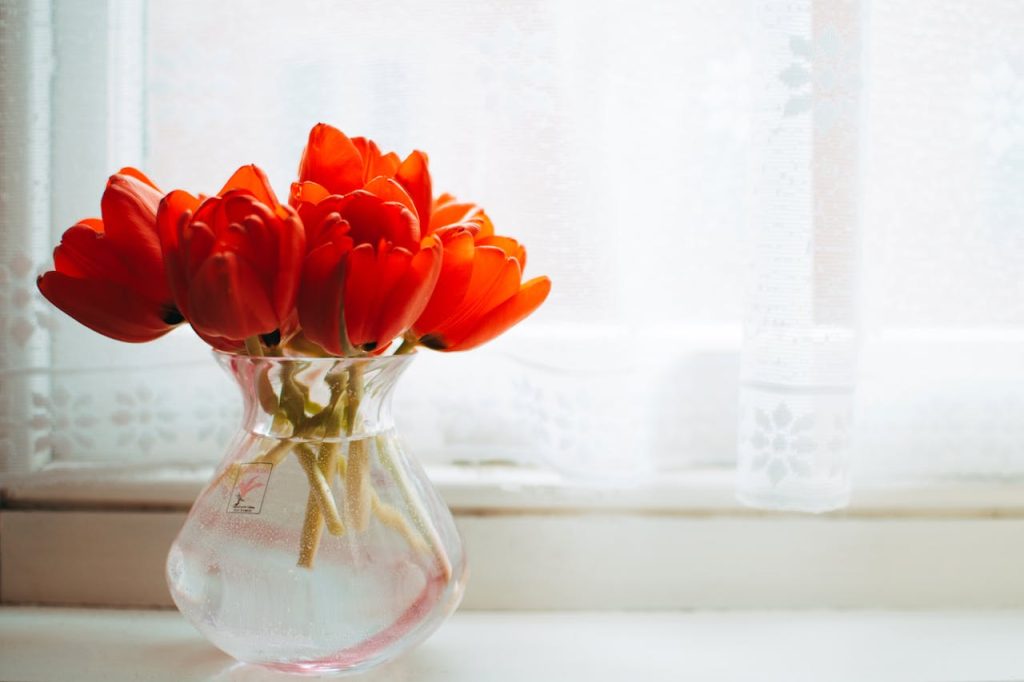Entering a house with well-selected flower décor is like entering a warm sanctuary of beauty. Combining colors, textures, and forms to create an environment that seems alive and welcoming, flowers have an amazing power to uplift any area. Floral décor is not only about aesthetics; it also greatly helps to define the character of a space. The beauty of flower arrangements is their adaptability; depending on your preferred look, they may be either stunning centerpieces or subdued accents. Whether your preference is for the timeless elegance of fresh flowers or the continuous attractiveness of synthetic arrangements, the suitable floral choices will bring life into your living space.
Selecting Floral Colors to Complement Your Interior Design
Your flower décor’s colors should complement the general palette of your homes to provide a harmonic visual flow. Selecting appropriate colors calls for knowledge of how tones interact with one another and how they affect the atmosphere of a room. While delicate pastels and whites may balance out strong wall colors and complex furniture designs, vivid hues like deep reds, bright yellows, and rich purples can lend life to neutral or minimalist environments. Flowers with vivid, contrasting colors may become focal points and eye-catching objects in settings predominated by neutral tones. Conversely, if your house is vibrantly colored, gentler flower tones might provide harmony and peace. Think about seasonal palettes as well; although brilliant pinks and greens are perfect for spring, warm colors like burnt orange and golden yellows look great in fall.
Combining Natural Accents with Artificial Flower Arrangements
The adaptability and long-lasting appeal of artificial flower arrangements have made them somewhat well-known. Artificial blossoms are ideal for people looking for low-maintenance décor options as they keep their beauty over time, unlike genuine flowers, which need continuous care. Including fake flowers does not imply, however, compromising authenticity. When combined with natural tones, they seem reasonable and appealing. Made from silk or another comparable material, high-quality fake flowers may mimic the minute textures and features of natural blossoms. Match them with natural materials like dried grasses, wood vases, or fresh vegetation to improve their realism. Artificial arrangements placed in well-lit spaces might also seem more vivid.
Considering the Floral Placement Purpose of the Room
Each area in your home has a distinct purpose. Hence, your flower arrangement should complement the atmosphere and use of every one of them. The living room, for instance, is a social center where striking, eye-catching layouts could promote warmth and vitality. Stunning visual impact may be produced from big vases loaded with vibrant flowers or cascading floral displays. On the other hand, bedrooms gain from gentle and soothing flower selections meant for rest. Perfect for dressers or bedside tables are delicate bouquets with lavender, eucalyptus, or soft-hued roses. For kitchens, use a small mason jar or ceramic pot configuration of herbs or vividly colored flowers to provide a fresh, domestic touch.
Managing Scale and Proportion for Optimal Effect
Their size and scale will influence the impression of your flower arrangements in a space. Bold statements in big, open locations like grand entrance ways of living rooms with high ceilings would be ideal for oversized flower displays. To provide vertical appeal, these configurations could include long stems like delphiniums or branches with flowering magnolias. Smaller areas, on the other hand, need subdued layouts that don’t dominate the space. Petite vases with delicate arrangements with short stems or small flower groups can accentuate coffee tables, shelves, or corners. Furthermore, take into account the size of your furniture; whereas minimalist furniture gains from subdued, streamlined floral décor, enormous furniture matches well with similarly significant arrangements. Finding the proper balance guarantees that your floral decorations accentuate the style of the area without overwhelming other components.
Building Texture for a Multidimensional Impact
Although it’s an often disregarded component in floral décor, texture is really essential in giving your arrangements volume and depth. Combining different textures of flowers adds visual appeal and helps to avoid a bland décor. To generate contrast, pair delicate blossoms like peony or ranunculus with organized greenery, such as ferns or monstera leaves. Your arrangements could also improve with the addition of non-floral accents such as twigs, dried seed pods, or feathers. These textural contrasts accentuate and add complexity by producing a multidimensional impact. If you want a rustic vibe, consider wooden pots or burlap-wrapped stems.
Conclusion
Floral décor can make an average house a haven of elegance and beauty. Combining colors, textures, and proportions with the character of your house produces a harmonic atmosphere that speaks to purpose and style. Whether your preference is for the classic beauty of fresh flowers or the enduring appeal of synthetic arrangements, careful floral selections clearly energize every area of your house. Your house may bloom into a pleasant and artistic refuge with the correct vision.

